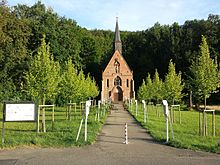Pilgrimage chapel Liebfrauenbrunn
The Roman Catholic pilgrimage chapel Liebfrauenbrunn between Werbach and Werbachhausen was first built in the late Gothic style in the 15th century . The current chapel was built in 1902 and is dedicated to Our Lady of Sorrows . It is a well-known pilgrimage chapel .
history
The Liebfrauenbrunn Chapel was first built at the beginning of the 15th century during the late Gothic period. The original chapel was an open field chapel, which is not mentioned in a document. During the renovation of the chapel, Georg Martin Erlenbach was made the builder in later oral traditions. Georg Martin Erlenbach was a Bütten speaker in Werbach and can be found in documents. He dedicated a wayside shrine to his dead wife near the chapel , which can still be found today.
There is a legend about the chapel that was passed on in the vernacular: In the summer, farm workers crossed the Geiz-Märtle field to quench their thirst with the spring water. Out of anger, the latter then poured mercury into the water to poison it. Because of this act God punished him: His son drowned in the swollen Welzbach and his wife died out of grief. He himself fell ill with a serious eye condition with the risk of blindness. Thereupon he vowed to look for the spring again and to have a chapel built because of his atonement and in honor of Our Lady of Sorrows . He then recovered and the spring reappeared in a different place with the same water . The chapel was in an unfavorable position as it was directly on the Welzbach and the source. The spring got a vault and the chapel got a choir with an altarpiece. The chapel was extended by an extension by moving the gable wall from the left bank to the right bank and vaulting the spring. To the left there was a bridge to cross the Welzbach.
A small tower containing a bell was placed on top of the gable. It says "Maria, Ere, Glorie, Maria", and seven crowns are arranged between the words. Due to the rottenness of the wood, the chapel was dismantled under Pastor Julius Krug and rebuilt in a larger square in 1902.
In February 2014, several rotten chestnut trees that formed an avenue to the chapel had to be felled. In October of the same year ten imperial linden trees were planted in their place.
Chapel building and equipment
Exterior construction
The new building of the chapel stands on the same place as the previous chapel, but is raised above the ground and the stream below. It was built in the Gothic style from red Taubertal sandstone. Stone walls have been built on both sides of the Liebfrauenbrunn chapel so that the church can be completely surrounded. In 1995 an outbuilding was built to the east of the chapel. In the outbuilding is a sacristy with a confessional room and toilets.
Interior
A second, larger bell was hung in the tower from the old church in Gamburg . The bell on the cloak has Rococo decorations and the inscription: “Johann Georg Imhoff, Schultheiss Ao. 1776 ".
The altar of grace was created by the sculptor Thomas Buscher .
- Altar of grace of the Liebfrauenbrunnkapelle
The ceiling has a large painting depicting Mary with the baby Jesus as the helper and refuge of the Christians, and was designed by the painter Glassen from Heidelberg . It also shows angels holding an outstretched cloak under which clergy and men of the world, especially the sick, find protection.
Way of the Cross
A small way of the cross with individual stations shows the way to the chapel.
Source under the pilgrimage chapel
The spring , which is located in the vault below the chapel, is said to have healing powers, especially for eye problems. The water is not checked, which is what a sign says. Any water can be fetched with the push of a button.
- Healing spring under the Liebfrauenbrunn chapel
Monument protection
The pilgrimage chapel is located at Liebfrauenbrunnstraße 34 and is a listed building . The following parts form an aggregate:
- Neo-Gothic chapel building with roof turrets and polygonal closure, inscribed in 1902.
- Wayside shrine with cross group, 1754 inscribed.
- Cast iron Stations of the Cross, around 1900.
Todays use
Nowadays, pilgrimage services are held regularly on Saturday mornings from May to October . The Liebfrauenbrunnkapelle of the pastoral care unit Großrinderfeld-Werbach serves as a meeting point for devotions of groups and parish associations from the deanery Tauberbischofsheim as well as groups from outside. Numerous church weddings take place in the chapel as well as thanksgiving services on the day of the golden, silver and diamond wedding anniversaries .
Web links
- Liebfrauenbrunnkapelle near the community of Werbach
Individual evidence
- ↑ a b c d e f g h i Municipality of Werbach: Liebfrauenbrunnkapelle . Online at www.werbach.de. Retrieved December 2, 2016.
- ↑ a b c d e f Chapel Liebfrauenbrunnstraße 34 Werbach - detail page - LEO-BW. In: leo-bw.de. Retrieved May 16, 2020 .
- ^ Fränkische Nachrichten: Liebfrauenbrunnkapelle. Tree planting on October 11th is celebrated with a big festival. An avenue of lime trees by the chapel . October 8, 2014. Online at www.fnweb.de. Retrieved July 18, 2017.
- ↑ a b pastoral care unit Großrinderfeld-Werbach: Werbach, Liebfrauenbrunnkapelle . Online at www.kath-grossrinderfeld.de. Retrieved December 2, 2016.
- ↑ a b Fränkische Nachrichten : Over the mountain to the source . Online at www.fnweb.de. Retrieved December 16, 2016.
Coordinates: 49 ° 40 '11.49 " N , 9 ° 39' 43.47" O








